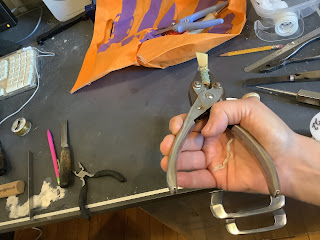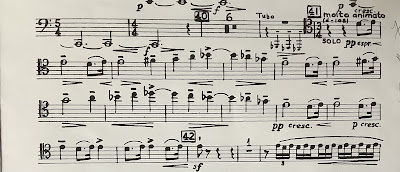In major metropolitan areas throughout the world, high school woodwind
players are afforded the opportunity to perform in local youth
orchestras, some of which are affiliated with professional orchestras. For students in the Columbus, Ohio area, the
Columbus Symphony Youth Orchestra
(CSYO) is a fine example of an organization which provides high level
orchestral experience for high school aged musicians. Based upon my experiences with the students of the CSYO, I've assembled a few pointers for young orchestral wind players.
One of the first basics an orchestral player must learn is how to follow the conductor and how to allow the conductor to provide the pulse of the music. Each musician in the orchestra relies on their individual sense of pulse, which is ideally locked into the pulse provided by the conductor. If you are not watching the conductor, then you may not know what their pulse is. (While focusing your eyes on your sheet music, you can still watch the conductor peripherally, but it doesn't happen automatically. While peripheral vision is always available, it doesn't do any good unless you notice it, or use it.) If you feel out of touch with your internal pulse, just practice more with a metronome so that when you turn off the metronome, you can still hear it in your mind. That's your internal pulse. Focusing on the conductor (and aligning your pulse with theirs) is particularly important for wind players, for unlike the string players, we are not members of large sections of musicians all playing the same parts.
Equally important is the goal of listening carefully to your orchestral colleagues, in your section and in other sections. Similarly to peripheral vision, your ability to hear others is always available, but it won't do any good unless you actively choose to hear the playing of others. Unless you consciously listen to others, you will only hear your own playing, ignoring how it fits in with the playing of the other musicians. When you listen carefully to your colleagues, you'll be able to figure out how to fit in stylistically, rhythmically, dynamically and pitch-wise. That's how you become a good ensemble player.
Timing is everything in music. It doesn't matter how well you play a passage if you're not playing it at precisely the correct time! Use your eyes to follow your conductor, and use your ears to fit in with your colleagues.
Pay attention to the conductor's words also! To this day I remember (and abide by) words of wisdom spoken by my youth orchestra conductor from high school. For example, once when a trumpet player was struggling with a technical passage, our conductor advised us to always practice with a handicap - if the passage is going to be performed at a tempo of 120, then it should be practiced at tempos up to 125. Conductors are teachers as well as musical leaders, and if you aren't paying attention, you might miss some valuable information about music in general or about the piece being rehearsed. Also, it goes without saying that if you're tuned in to your conductor, then you'll always know where in the music you'll be starting, and you'll be ready to play on time. Remember: timing is everything!
The importance of CONFIDENCE
In any orchestra of any level, the woodwind players are soloists. Since each wind position is a solo position, it makes sense to encourage wind players to play with great confidence.
As a bassoon student of K. David Van Hoesen, I was taught that if I wanted to succeed as a musician, it would be necessary to play with absolute conviction. That means playing with great strength and authority, as though you totally know what you're doing, as though you know beyond doubt what the music is supposed to sound like, and you know how to deliver it. It means playing out, with a full sound, which is particularly important for a bassoonist because the bassoon has the most limited dynamic range of the orchestral instruments. It means playing with confidence.
The best way I know of to gain confidence is to prepare thoroughly to the best of your ability. That means listening to recordings of the music you're playing, and writing helpful notes in your part. For example, if you hear on the recording that you have an exposed passage in octaves with the 2nd oboe, write that in your part. If you hear that one of your passages is not played by any other instrument, write "solo" in your part to avoid being caught by surprise.
It also means spending adequate time practicing your parts. Learn the notes, of course, using effective practice techniques such as slow practice, and use the metronome and tuner! Those devices teach you how to play with good intonation, accurate rhythm and a steady pulse. That will boost your confidence! One of my own consistent practice techniques is to practice passages with a tuning drone to check intonation, which is especially effective for bassoon players considering our pitch instability. Woodwind players often augment their practicing by playing along with recordings of the orchestral works they're preparing. (Even professionals do that sometimes!)
What do wind players do while the conductor is rehearsing another section of the orchestra? Oftentimes it's wise to listen to what the conductor says to other sections because it can inform your own playing. Also, it may be a good use of your time to finger through your own part (moving your fingers as though playing the part, but without blowing into your instrument) while another section is being rehearsed (either silently "playing" along with the passage being rehearsed, or silently "playing" a different passage you're concerned about). Definitely do not check your phone or daydream, since you never know when your section will be called upon and it's best to be ready to jump in.
If you do those things (listen to recordings, mark your music, practice your parts assiduously with metronome and tuner, watch and listen during rehearsals) then there is no reason for you NOT to play with confidence! Preparation enables you to do your best, which naturally inspires confidence.
Confidence, of course, is a mindset, which may be applied even when you do not feel that you've had quite enough time to prepare. Even in the professional orchestral world, confidence is not always felt by the player, but can be displayed anyway! If you're not feeling confident, then fake it, since confident playing is guaranteed to bring a better result than shy, timid playing! It makes much sense to develop the habit of playing with confidence at all times, in any situation (including sight reading) while reinforcing and justifying your confident mindset with careful, contentions preparation and mindful attentiveness during rehearsals and concerts.
The earlier you take on the aura of confidence, the better! It will serve you well throughout your life.
































